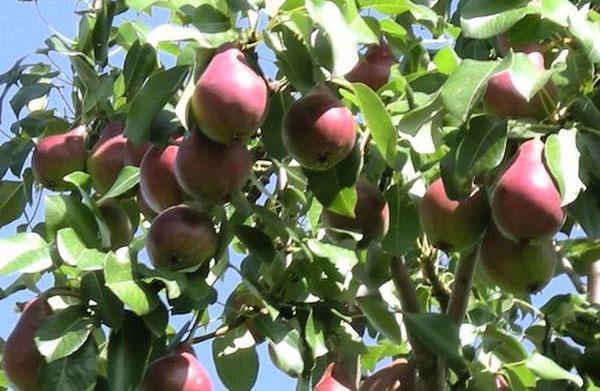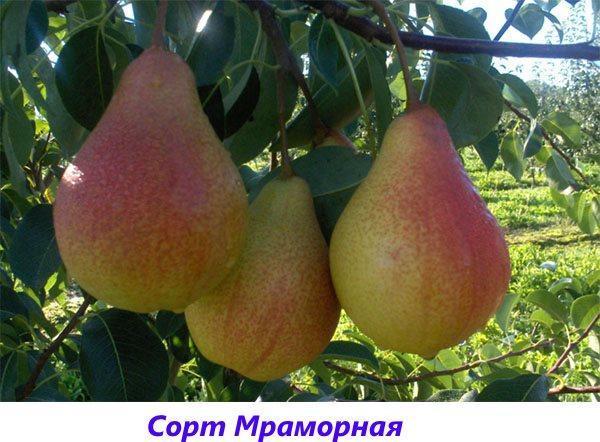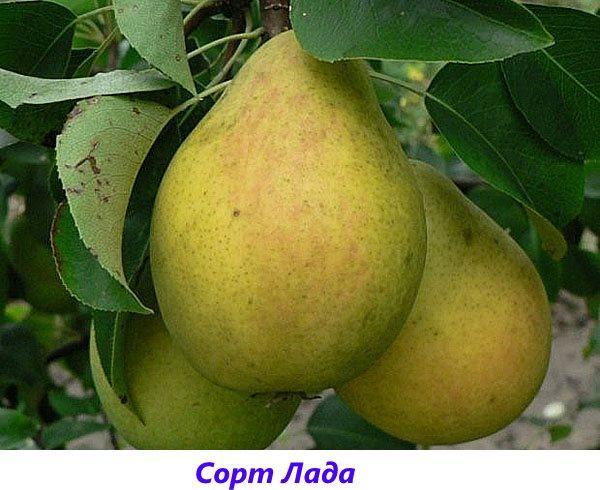Pears for the Moscow Region - varieties that will delight the gardener
 The gardens of the Moscow region are more and more reminiscent of the southern ones. Botanists have developed pears for the Moscow region - varieties for summer, autumn and winter use. There are spreading trees and columnar pears that can fit in a small area. To help the gardener, we offer a description of some varieties, not all.
The gardens of the Moscow region are more and more reminiscent of the southern ones. Botanists have developed pears for the Moscow region - varieties for summer, autumn and winter use. There are spreading trees and columnar pears that can fit in a small area. To help the gardener, we offer a description of some varieties, not all.
Early varieties
Early varieties of pears for the Moscow region are characterized by self-fertility. To get a harvest, 2-3 trees should be planted nearby, it is better if one of them is of a different variety. Self-fertility, supplemented by cross-pollination, increases the number of ovaries.

 The variety belongs to the new, fast-growing standard. The tree grows up to 2.5 m, first forms a funnel, then rises as a pyramid. This is one of the earliest varieties, pictured is a Lada pear before harvest in July. The fruits are not large, 90 - 110 g, but the yield is about 40 kg from one adult tree. Fruiting occurs 2-4 years after planting.
The variety belongs to the new, fast-growing standard. The tree grows up to 2.5 m, first forms a funnel, then rises as a pyramid. This is one of the earliest varieties, pictured is a Lada pear before harvest in July. The fruits are not large, 90 - 110 g, but the yield is about 40 kg from one adult tree. Fruiting occurs 2-4 years after planting.
Variety advantages:
- high winter hardiness;
- resistance to bacterial burns, scab;
- low requirements for lighting;
- good yield.
The variety is self-pollinated, but in the presence of a Rogneda or Chizhovskaya pear, fruiting is more abundant. Sometimes another variety is grafted into the crown of the main tree.
 The variety is early ripening, the fruits reach 250 grams, but the tree is very tall and harvesting is difficult. The early harvest is stored for no more than 2 weeks, the fruits are tasty, aromatic and in early summer they are sold quickly. Pears are used for conservation, preparation of mashed potatoes, juices.
The variety is early ripening, the fruits reach 250 grams, but the tree is very tall and harvesting is difficult. The early harvest is stored for no more than 2 weeks, the fruits are tasty, aromatic and in early summer they are sold quickly. Pears are used for conservation, preparation of mashed potatoes, juices.
Pear Fairy belongs to varieties with natural immunity to gall mites and scab. After frostbite, the tree quickly restores the crown.
 The variety was bred in the South Ural Research Institute of Chelyabinsk. The author of the variety is E.A. Falkenberg. Krasulia pear is included in the State Register in 2002. A tree up to 4 meters high has a spreading crown and medium overgrowth. The thorns on the branches make harvesting difficult. The crop is tied on ringlets, last year and young growth.
The variety was bred in the South Ural Research Institute of Chelyabinsk. The author of the variety is E.A. Falkenberg. Krasulia pear is included in the State Register in 2002. A tree up to 4 meters high has a spreading crown and medium overgrowth. The thorns on the branches make harvesting difficult. The crop is tied on ringlets, last year and young growth.
Krasuli's fruits are small, 90-120 grams, flattened-rounded. When the pear is ripe, it turns yellowish-green with a bright blush. The variety is intended for industrial breeding and private households.
Advantages:
- high productivity;
- resistance to scab, bacterial burn, pear mite;
- good winter hardiness.
Early varieties cannot be stored for a long time, they require quick implementation or processing.
Late summer pear varieties
The pear varieties harvested in the second half of August for the Moscow region are more mature.
 The South Ural variety was bred in the community of Chelyabinsk and Yekaterinburg breeders. The tree is medium-sized, round, with low self-fertility. A pollinator is required, such as Krasulya or Severyanka. The variety is very hardy. Frost resistance of Rainbow pear is declared -37.20, but with a little freezing, seedlings and mature trees endured 48.30 in the winter of 1978-1979.
The South Ural variety was bred in the community of Chelyabinsk and Yekaterinburg breeders. The tree is medium-sized, round, with low self-fertility. A pollinator is required, such as Krasulya or Severyanka. The variety is very hardy. Frost resistance of Rainbow pear is declared -37.20, but with a little freezing, seedlings and mature trees endured 48.30 in the winter of 1978-1979.
Fruits weighing up to 140 g are rated at 4.5 points in taste. The pulp is sour-sweet, aromatic.Fruits in a ripe state can sag for 10 days without shedding, then spoil. The harvested crop can be stored for a week.
Advantages:
- excellent commercial quality of fruits;
- high winter hardiness;
- resistance to diseases and pests.
 We owe the emergence of a new variety to genetics S.P. Yakovlev, who crossed the local resistant variety Tenderness with the Australian Triumph Pakgam. In the photo - a pear August dew, in all its splendor.
We owe the emergence of a new variety to genetics S.P. Yakovlev, who crossed the local resistant variety Tenderness with the Australian Triumph Pakgam. In the photo - a pear August dew, in all its splendor.
The tree is low, compact, with a drooping crown, medium density. The tree begins to bear fruit at 4 years old, the variety Pamyat Yakovlev can serve as a pollinator.
Fruits weighing 120-140 g are green when ripened, turn yellow and acquire a slight blush when ripened. Keeping up to 3 weeks. Evaluation of palatability 4.6 - 5 points. Fruiting is regular. The pear variety Avgustovskaya dew is resistant to scab, is little affected by leaf-eating insects. When overloaded with fruits, the tree weakens.
 The variety is old, folk selection. Ripe fruits do not have ripe seeds. But the variety is prone to scab. The tree is tall, the fruits are small, 70 - 80 g. Fruits ripen in August, are stored for a week. Ripe Bessemyanka pears crumble, remaining on the branch, increase in volume, the pulp deteriorates. The variety tolerates the winter of the Moscow region normally. The yield of an adult tree is about 270 kg.
The variety is old, folk selection. Ripe fruits do not have ripe seeds. But the variety is prone to scab. The tree is tall, the fruits are small, 70 - 80 g. Fruits ripen in August, are stored for a week. Ripe Bessemyanka pears crumble, remaining on the branch, increase in volume, the pulp deteriorates. The variety tolerates the winter of the Moscow region normally. The yield of an adult tree is about 270 kg.
Pears bearing fruit in late August, early September
 Pear bred by scientists of the Moscow Agricultural Academy named after K.A.Timiryazev. The result is a universal variety, depending on the region, it is classified as late summer, early autumn, autumn. In the Moscow region, the fruits are removed at the junction of summer and autumn. They are ripened and stored in cool conditions for up to 3 months. The skin is light yellow with an indistinct pattern. The pulp is white, sweet.
Pear bred by scientists of the Moscow Agricultural Academy named after K.A.Timiryazev. The result is a universal variety, depending on the region, it is classified as late summer, early autumn, autumn. In the Moscow region, the fruits are removed at the junction of summer and autumn. They are ripened and stored in cool conditions for up to 3 months. The skin is light yellow with an indistinct pattern. The pulp is white, sweet.
Advantages of Rogned pear:
- not afraid of Russian winters;
- resistant to all kinds of diseases;
- is fast-growing;
- yield up to 50 kg per tree.
The tree grows up to 10 m tall, unpretentious in care, used in breeding work.
Large and very tasty fruits ripen in early September, but not all. The period of maturity is extended, but the fruits do not crumble, and they can be removed in batches. A soft juicy pear is not suitable for storage. It is better to immediately process the crop for harvesting.
 Pear Vidnaya is a winter-hardy variety, little susceptible to fungal diseases. Possesses good frost resistance. Fruiting occurs in the 5th year.
Pear Vidnaya is a winter-hardy variety, little susceptible to fungal diseases. Possesses good frost resistance. Fruiting occurs in the 5th year.
 A low tree, up to 3 meters, will give the residents of the Moscow region in September the most beautiful fruits. However, delicate pears can be stored for no more than a week. In description, Chizhevsky's pear with a three-meter growth, it is capable of giving a decent harvest. The pear bears fruit regularly. The seedling is grown on a dwarf rootstock, blooms in the third year. Despite the declared self-fertility, the tree is better tied with the Lada pollinator.
A low tree, up to 3 meters, will give the residents of the Moscow region in September the most beautiful fruits. However, delicate pears can be stored for no more than a week. In description, Chizhevsky's pear with a three-meter growth, it is capable of giving a decent harvest. The pear bears fruit regularly. The seedling is grown on a dwarf rootstock, blooms in the third year. Despite the declared self-fertility, the tree is better tied with the Lada pollinator.
 Autumn pear variety Nadyadnaya Efimova has an early type of fruiting. The variety won a gold prize in the 80s of the last century at an international fair in Germany. The variety is widespread throughout the European part of Russia and the Baltic states. Has the characteristic of palatability of fruits by 4.5. Possesses complex resistance to diseases, pests and climatic resistance.
Autumn pear variety Nadyadnaya Efimova has an early type of fruiting. The variety won a gold prize in the 80s of the last century at an international fair in Germany. The variety is widespread throughout the European part of Russia and the Baltic states. Has the characteristic of palatability of fruits by 4.5. Possesses complex resistance to diseases, pests and climatic resistance.
Autumn pear varieties with a long shelf life
Do not be surprised if at the New Year's table of the owner of a dacha outside Moscow you happen to see pears from his own garden. You can save the fruits of winter varieties until January.
 Large fruits weighing 180 grams drain when bitten. Pears are fragrant and tasty, with a slight tart aftertaste, but they need to be removed from the tree early. A ripe red-sided pear does not hold on to a branch. The variety has retained the best properties during breeding, and has the following advantages:
Large fruits weighing 180 grams drain when bitten. Pears are fragrant and tasty, with a slight tart aftertaste, but they need to be removed from the tree early. A ripe red-sided pear does not hold on to a branch. The variety has retained the best properties during breeding, and has the following advantages:
- frost resistance is high, at -50 freezing 3 points;
- fruitful, with high quality fruits;
- undemanding to the composition of the soil;
- an adult tree regulates the crop itself, pruning is not required;
- not damaged by scab, resistant to insect pests.
Fruiting of a red-sided pear occurs at 6-7 years.
 Only at the end of September does the Hera pear ripen, presenting the owner with fruits of amazing taste and an average size of 200 grams. Sweet and sour white pulp, granular structure are the distinctive features of this variety. There are no pears that are more shelf-stable. These will lie for 5 months in a cool barn.
Only at the end of September does the Hera pear ripen, presenting the owner with fruits of amazing taste and an average size of 200 grams. Sweet and sour white pulp, granular structure are the distinctive features of this variety. There are no pears that are more shelf-stable. These will lie for 5 months in a cool barn.
The Hera pear tree is of medium height, does not thicken, in the form of a narrow pyramid. Begins to bear fruit for 5 years. Freezing is partial, up to 1.8 points occurs when the temperature drops to - 380... The variety is resistant to bacterial and fungal diseases.
 The variety has immortalized the memory of the breeder who worked on its creation. Fruiting of a pear Yakovlev's favorite comes at 5-6 years. The fruits are beautiful, with a dotted pattern and blush over a delicate yellow-green background. The aroma of quince is characteristic in the aftertaste, but without astringency.
The variety has immortalized the memory of the breeder who worked on its creation. Fruiting of a pear Yakovlev's favorite comes at 5-6 years. The fruits are beautiful, with a dotted pattern and blush over a delicate yellow-green background. The aroma of quince is characteristic in the aftertaste, but without astringency.
The tree is fast-growing, overgrown, damaged by scab in damp years. The yield increases with age, at 7 years it is 20-22 kg. Good winter hardiness.
There are many more varieties that deserve the attention of gardeners in the Moscow region.